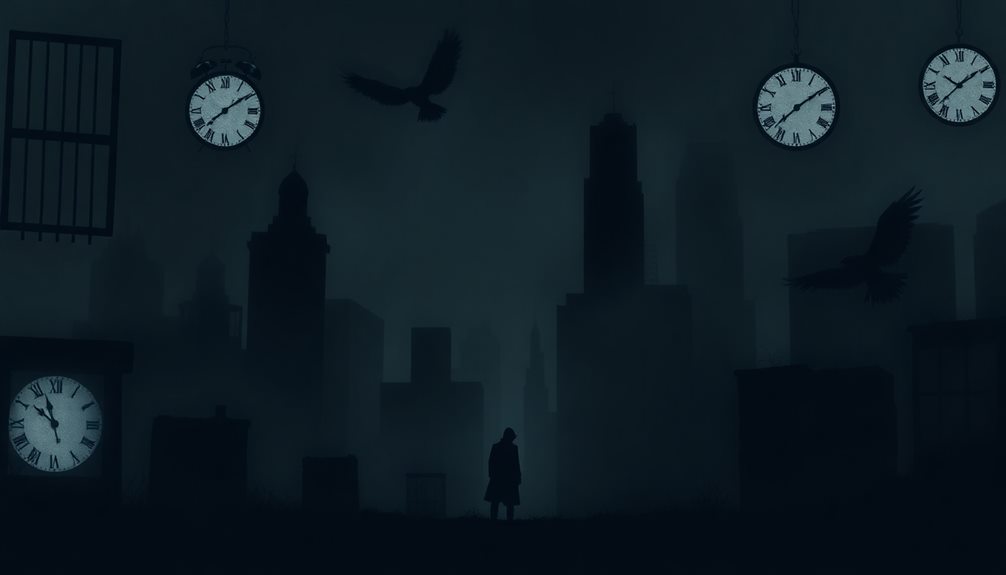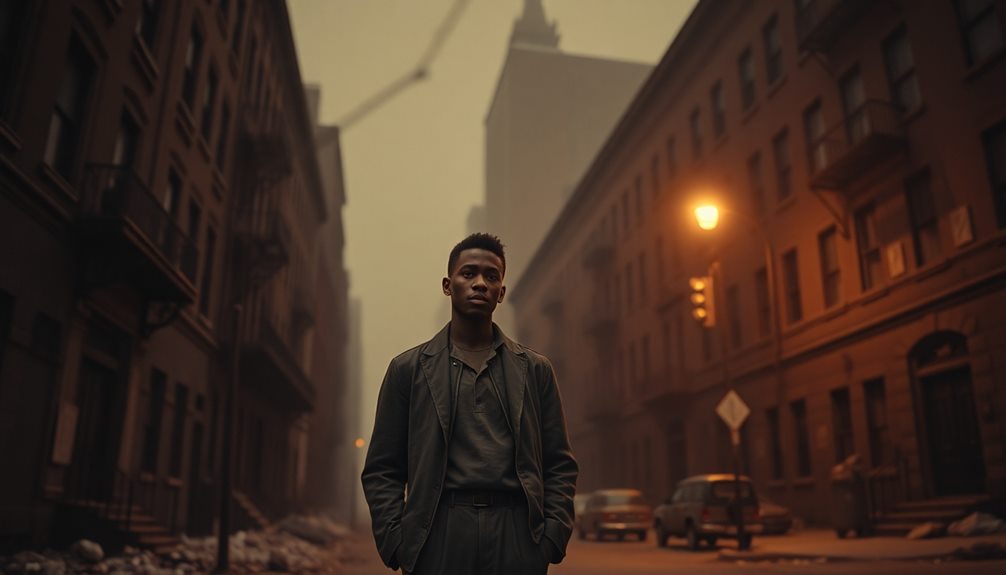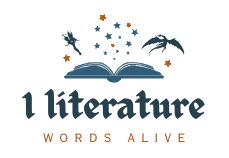Richard Wright's "Native Son" is a landmark novel that tackles systemic racism through the life of Bigger Thomas, a young Black man trapped in a harsh society. The story unfolds in three parts: Fear, Flight, and Fate, each revealing Bigger's internal struggles and external conflicts shaped by prejudice. Characters like Mary Dalton and Boris Max highlight the racial dynamics and ignorance of privilege. As you follow Bigger's journey, you witness the psychological impacts of oppression and violence. This provocative work pushes you to confront uncomfortable truths about race and identity. There's much more to explore about its themes and significance.
Overview of Richard Wright
Richard Wright stands as a monumental figure in American literature, particularly in the domain of African American writing. Born in 1908 in Mississippi, he faced extreme poverty and a challenging family life. His father's abandonment and his mother's illness shaped his early experiences, driving him to Chicago in 1927.
In Chicago, you'll find Wright deeply involved in literary circles and the Communist Party, which greatly influenced his writing and political outlook. His early works, like "Cesspool" and "Uncle Tom's Children," explore the harsh realities faced by Black men in America, examining themes of systemic racism and oppression.
But it was "Native Son," published in 1940, that catapulted him to fame. This novel introduced readers to Bigger Thomas, a character embodying the struggles against racial oppression and identity crises in a racially divided society. Selling 250,000 copies within three weeks, "Native Son" established Wright as a vital voice in African American literature.
Throughout his career, he tackled themes of race, identity, and societal oppression, ultimately becoming a pivotal figure in the Harlem Renaissance, influencing countless future writers and shaping the landscape of American literature.
Main Characters and Their Roles
In "Native Son," you'll see how Bigger Thomas grapples with his internal struggles, shaped by the oppressive forces of systemic racism.
The novel poignantly captures the dehumanizing effects of racism and systemic oppression, illustrating how these forces dictate Bigger's sense of identity and his actions.
As you explore the racial dynamics between characters like the Daltons and Bigger, you'll notice how privilege often blinds them to the harsh realities faced by those they claim to support.
Each character's role not only highlights these tensions but also serves as a powerful symbol of the societal issues at play, particularly in the context of the complexities of power dynamics.
Protagonist's Internal Struggle
Bigger Thomas' internal struggle unfolds against a backdrop of systemic racism and oppression, shaping his identity and actions throughout *Native Son*. As a 20-year-old African American man, he grapples with feelings of fear and powerlessness that fuel his violent outbursts. This dynamic not only reflects his struggle for existence but also deepens his sense of alienation in a society that devalues him.
His relationship with Mary Dalton symbolizes both a yearning for connection and the complexities of interracial dynamics. Her tragic death becomes a pivotal moment, exacerbating Bigger's internal conflict and leaving him feeling even more isolated.
The character of Mrs. Dalton serves as a stark contrast, representing ignorance toward the harsh realities of racial issues. Her blindness fails to recognize Bigger's lived experiences, highlighting the societal blind spots that contribute to his turmoil.
Meanwhile, Boris Max, Bigger's Jewish lawyer, attempts to provide a nuanced understanding of Bigger's actions, framing them within the context of systemic oppression. This exploration of Bigger's identity reveals the complexities of his internal struggle, reflecting the broader implications of race and oppression in America.
Racial Dynamics Explored
The racial dynamics in *Native Son* are intricately woven into the fabric of the main characters, each reflecting different aspects of systemic oppression. You can see how Richard Wright illustrates these dynamics through the lives of his characters:
- Bigger Thomas – The protagonist, he embodies the struggles of Black identity, showcasing the psychological effects of systemic racism in 1930s Chicago.
- Henry Dalton – A wealthy real estate owner, he represents racial blindness, believing his support for African Americans absolves him of understanding their daily realities.
- Mary Dalton – Though progressive and seeking racial equality, she fails to grasp her privilege, impacting individuals like Bigger without realizing it.
- Jan Erlone – Mary's Communist boyfriend attempts to treat Bigger as an equal, yet he becomes a scapegoat, highlighting the complexities of interracial relationships amidst systemic oppression.
Through these characters, Wright underscores the stark contrast between black and white experiences, revealing how each character's role perpetuates or challenges the American Dream.
This exploration lays bare the uncomfortable truths about racial dynamics, pushing readers to confront the realities of white society and its implications for people like Bigger.
Symbolism of Privilege
Examining the symbolism of privilege in *Native Son* reveals how deeply entrenched societal structures shape the experiences of its characters. Bigger Thomas, traversing a world dominated by racial privilege, faces the oppressive dynamics imposed by the Daltons.
Henry Dalton embodies white privilege, believing his real estate efforts support African Americans, yet he remains blissfully ignorant of the systemic barriers they confront. Mrs. Dalton, despite being physically blind, symbolizes the ignorance that often accompanies privilege; her charitable gestures fail to grasp the harsh realities of Black existence, perpetuating a facade of equality.
Mary Dalton, while appearing progressive, inadvertently showcases her privilege through her lack of understanding regarding Bigger's struggles. Her relationship with him, though well-intentioned, highlights the disconnect between her social status and the oppressive environment Bigger endures.
Jan Erlone, Mary's boyfriend, attempts to treat Bigger as an equal but also reinforces privilege by not acknowledging the societal barriers Bigger faces daily.
Meanwhile, Bessie Mears, Bigger's girlfriend, reflects the intersection of gender and race, revealing additional layers of oppression within this privileged society. Together, these characters illustrate the complexities of privilege and its profound impact on their lives.
Plot Summary and Structure

Divided into three compelling books—Fear, Flight, and Fate—*Native Son* intricately explores the life of Bigger Thomas and the devastating consequences of his actions.
Richard Wright crafts a narrative that not only tells Bigger's story but also illustrates the systemic causation of racial oppression in America, a theme deeply rooted in Wright's own upbringing in racially charged South.
The novel serves as a powerful commentary on the struggles faced by Black Americans, reflecting Wright's commitment to challenging social norms and advocating for equality.
Here's a brief plot summary of the three books:
- Book One: Fear – You witness Bigger's life in poverty, culminating in his violent act of killing Mary Dalton, which sparks a chain of events.
- Book Two: Flight – Bigger's attempts to cover up his crime lead to escalating tensions, including the tragic murder of his girlfriend Bessie and a fabricated kidnapping narrative.
- Book Three: Fate – Bigger faces his trial, reflecting on his life choices shaped by societal forces, ultimately leading to his tragic fate.
The structure of the novel mirrors Bigger's psychological journey, highlighting how systemic racism and oppression impact his identity and decisions.
Through this progression, Wright reveals the profound consequences of Bigger's life within a racially oppressive society.
Key Themes Explored
Richard Wright's *Native Son* reveals powerful themes that resonate throughout Bigger Thomas's journey, further enhancing the impact of the story. One of the most striking themes is systemic racism, which profoundly shapes Bigger's identity and actions. The psychological impacts of oppression manifest in his resort to violence, a twisted form of self-actualization that reflects his desperation and the alienation he experiences in a racially charged environment.
This exploration of systemic inequities parallels the historical injustices highlighted in the complexities of medical research seen in *The Immortal Life of Henrietta Lacks*, showcasing how marginalized individuals are often subjected to societal neglect.
Fear and powerlessness dominate Bigger's life, as societal structures limit his choices, leading to tragic consequences. This sense of entrapment highlights the broader social conditions faced by African Americans in 1930s Chicago.
The theme of racial blindness emerges through characters like the Daltons, who, despite their good intentions, remain oblivious to the systemic inequities that define Bigger's existence, underscoring the disconnect between intention and impact.
Isolation and alienation further complicate Bigger's identity formation, as he grapples with profound loneliness within his community and in interactions with white characters.
Wright masterfully intertwines these themes, painting a vivid picture of the struggles faced by those marginalized by society, ultimately prompting readers to confront uncomfortable truths about race and identity.
Symbolism and Motifs

In "Native Son," blindness symbolizes the ignorance of the privileged white society towards the struggles of African Americans, highlighting systemic oppression.
This theme resonates with the complexities of identity and culture within the Black experience, similar to how Ta-Nehisi Coates explores these issues in his work, particularly in his exploration of systemic racism.
You'll also see how violence emerges as a means of escape for Bigger, reflecting his desperate attempt to break free from an oppressive reality.
These symbols and motifs deepen your understanding of the characters' experiences and the broader social commentary at play.
Blindness and Ignorance
Throughout "Native Son," the theme of blindness serves as a powerful symbol of the ignorance that privileged white individuals have towards the struggles of Black Americans. This blindness manifests in various characters and situations, highlighting a critical disconnect between their perceptions and the harsh realities faced by Black individuals. Here are four key aspects to reflect upon:
- Mrs. Dalton's Blindness: Her literal blindness symbolizes the larger ignorance of white society regarding racial struggles.
- Henry Dalton's Philanthropy: Despite his charitable actions, he remains oblivious to the systemic oppression his tenants endure.
- Bigger Thomas's Conflict: His internal strife illustrates the psychological impact of being viewed through the distorted lens of white ignorance.
- Critique of White Liberals: Wright exposes a false sense of understanding among white characters, revealing their lack of genuine awareness.
The repeated references to blindness throughout the novel emphasize the need for deeper engagement with the realities of systemic oppression.
Violence as Escape
As the theme of blindness reveals the ignorance surrounding racial oppression, it sets the stage for understanding how violence becomes a means of escape for Bigger Thomas. In *Native Son*, Bigger, a young Black man, grapples with the weight of systemic racism that confines his identity and dreams. His inner turmoil manifests in violence, which he sees as a way to assert control over a life marked by oppression.
The pivotal murder of Mary Dalton represents a moment where he briefly feels powerful, highlighting the psychological impact of his circumstances. Bigger's violent actions, including the brutal assault on Bessie, illustrate the cyclical nature of violence in his life—serving both as a coping mechanism and a path to self-destruction.
Wright uses these instances to show how Bigger's desperate need for self-actualization drives him towards acts that ultimately erase his humanity. The furnace, a recurring symbol, signifies the destructive consequences of his violence, consuming his identity and leaving him trapped in an inescapable cycle.
Through Bigger's experiences, Wright poignantly critiques the oppressive forces that render such violence a tragic escape.
Critical Reception and Impact
*Native Son* burst onto the literary scene in 1940, enthralling readers and critics alike with its unflinching portrayal of racial injustice. Richard Wright's groundbreaking novel quickly became a bestseller, selling 250,000 copies within just three weeks.
This remarkable achievement established him as a prominent voice in American literature and marked a significant moment for African American authors, reminiscent of the collective action seen in World War II resistance movements, where bravery and unity highlighted the struggle against oppression acts of resistance.
Here are four key aspects of its critical reception and impact:
- Bestseller Status: *Native Son* was the first work by an African American author selected by the Book of the Month Club, greatly boosting its visibility.
- Praise for Honesty: Critics lauded the novel for its raw depiction of the psychological impact of systemic oppression on Black individuals.
- Controversial Representation: Despite its acclaim, some argued that the portrayal of Black characters reinforced negative stereotypes, sparking debates about authenticity.
- Challenged Work: The novel remains frequently challenged due to its graphic content, yet it's defended for engaging with complex social issues.
Ultimately, *Native Son* continues to resonate, prompting essential discussions on race and identity in America.
Richard Wright's Background

Richard Wright's upbringing in the Deep South profoundly shaped his worldview and literary voice. Born on September 4, 1908, in a sharecropper's cabin in Mississippi, he faced poverty and familial instability, with his father abandoning the family and his mother suffering from chronic illness.
These early experiences influenced his portrayal of Bigger Thomas in "Native Son," a character emblematic of the struggles faced by many in the Black experience. Wright's life echoes the narratives of forgotten figures like Ida B. Wells who fought against systemic oppression, highlighting the resilience found in marginalized voices.
In 1927, Wright moved to Chicago, where he found work at the Post Office and immersed himself in literary circles. By joining the John Reed Club in 1933, he began to hone his craft, eventually publishing "Uncle Tom's Children" in 1938, which addressed the harsh realities of racial oppression and established his place in American literature.
Wright initially aligned with the Communist Party in the 1930s, seeing it as a path toward social change and racial justice. His engagement with these themes allowed him to grapple with the complexities of race relations in America, making significant contributions that resonate throughout his works, including "Native Son."
Legacy and Cultural Significance
Published in 1940, *Native Son* quickly became a cultural touchstone, selling over 250,000 copies within just three weeks. Richard Wright made history as the first African American author featured by the Book of the Month Club.
This landmark novel not only became a bestseller but also challenged traditional narratives about race in America, much like how *The Book Thief* explores themes of resilience and courage in oppressive circumstances amidst Nazi Germany.
Here are four key reasons for its legacy and cultural significance:
- Raw Portrayal of Systemic Racism: The novel presents an unflinching look at the psychological effects of systemic racism on African Americans.
- Influence on Literature: It's recognized as a pivotal work in African American literature, inspiring later generations to explore themes of race, identity, and social justice, paralleling how storytelling in *The Book Thief* serves as a means of empowerment and defiance against censorship the power of storytelling.
- Broadway Adaptation: Its adaptation into a Broadway play directed by Orson Welles in 1941 brought its themes to a wider audience, solidifying its impact.
- Continued Relevance: Despite facing criticism for reinforcing stereotypes, *Native Son* remains relevant today, ranking 71 on the ALA's list of frequently challenged books, reflecting ongoing discussions about race and identity in society.
Educational Resources and Further Reading

For those looking to explore deeper into *Native Son*, a wealth of educational resources is available to enhance your understanding of its complex themes and characters.
Start with study guides like SparkNotes, which offer thorough summaries, character analyses, and thematic discussions that break down Richard Wright's powerful narrative on racism and identity. Additionally, consider how Wright's work resonates with the broader theme of stories of survival and resilience, reflecting the struggles faced by marginalized individuals throughout history.
You can also benefit from video lessons on platforms like Study.com, where over 30,000 educational videos include specific lessons on *Native Son*. These visuals can help solidify your grasp of the text's intricate themes.
Furthermore, reading critical essays from various academic journals will provide insights into the impact and significance of Wright's work, particularly regarding racial dynamics.
Documentaries about Richard Wright and the historical context of *Native Son* are another excellent resource, offering a deeper look into the author's life and the societal issues he confronted.
Conclusion
In exploring "Native Son," you uncover the intricate layers of Richard Wright's powerful narrative, revealing not just a story but a mirror reflecting societal truths. Coincidentally, as you immerse yourself in Bigger Thomas's journey, you might find echoes of your own struggles against preconceived notions. This connection can spark deeper conversations about race, identity, and the search for freedom. Ultimately, Wright's work invites you to challenge the status quo and reflect on the world around you.



